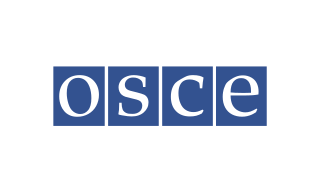
Environmental laws are laws that protect the environment. Environmental law is the collection of laws, regulations, agreements and common law that governs how humans interact with their environment. This includes environmental regulations; laws governing management of natural resources, such as forests, minerals, or fisheries; and related topics such as environmental impact assessments.Environmental law is seen as the body of laws concerned with the protection of living things from the harm that human activity may immediately or eventually cause to them or their species, either directly or to the media and the habits on which they depend.

The Food and Agriculture Organization of the United Nations (FAO) is a specialized agency of the United Nations that leads international efforts to defeat hunger and improve nutrition and food security. Its Latin motto, fiat panis, translates to "let there be bread". It was founded on 16 October 1945.

The Organization for Security and Co-operation in Europe (OSCE) is a regional security-oriented intergovernmental organization comprising member states in Europe, North America, and Asia. Its mandate includes issues such as arms control, the promotion of human rights, freedom of the press, and free and fair elections. It employs around 3,460 people, mostly in its field operations but also in its secretariat in Vienna, Austria, and its institutions. It has observer status at the United Nations.

The United Nations Economic Commission for Europe is one of the five regional commissions under the jurisdiction of the United Nations Economic and Social Council. It was established in order to promote economic cooperation and integration among its member states.
The Forest Principles is a 1992 document produced at the United Nations Conference on Environment and Development. It is a non-legally binding document that makes several recommendations for conservation and sustainable development forestry.

Illegal logging is the harvest, transportation, purchase, or sale of timber in violation of laws. The harvesting procedure itself may be illegal, including using corrupt means to gain access to forests; extraction without permission, or from a protected area; the cutting down of protected species; or the extraction of timber in excess of agreed limits. Illegal logging is a driving force for a number of environmental issues such as deforestation, soil erosion and biodiversity loss which can drive larger-scale environmental crises such as climate change and other forms of environmental degradation.

Certified wood and paper products come from responsibly managed forests – as defined by a particular standard. With third-party forest certification, an independent standards setting organization (SSO) develops standards for good forest management, and independent auditing companies issue certificates to forest operations that comply with those standards.

Forestry laws govern activities in designated forest lands, most commonly with respect to forest management and timber harvesting. Forestry laws generally adopt management policies for public forest resources, such as multiple use and sustained yield. Forest management is split between private and public management, with public forests being sovereign property of the State. Forestry laws are now considered an international affair.

The Programme for the Endorsement of Forest Certification (PEFC) is an international, non-profit, non-governmental organization which promotes sustainable forest management through independent third-party certification. As of 2006, it was considered the certification system of choice for small forest owners in Europe.

Sustainable forest management (SFM) is the management of forests according to the principles of sustainable development. Sustainable forest management has to keep the balance between three main pillars: ecological, economic and socio-cultural. The goal of sustainable forestry is to allow for a balance to be found between making use of trees and also maintaining natural patterns of disturbance and regeneration. The forestry industry mitigates climate change by boosting carbon storage in growing trees and soils and improving the sustainable supply of renewable raw materials via sustainable forest management.

The International Union of Forest Research Organizations (IUFRO) is a non-profit, non-governmental international network of forest scientists, headquartered in Austria. In 2019, IUFRO counted 630 Member Organizations worldwide.

The Baltic Marine Environment Protection Commission is an intergovernmental organization governing the Convention on the Protection of the Marine Environment of the Baltic Sea Area. A regional sea convention and a platform for environmental policy making at the regional level, HELCOM works for the protection of the marine environment of the Baltic Sea. HELCOM consists of ten members – the nine Baltic Sea countries Denmark, Estonia, Finland, Germany, Latvia, Lithuania, Poland, Russia and Sweden, plus the European Union.

The International Forestry Students’ Association (IFSA) is an international network of students in forestry-related sciences. It is a globally organized and locally operated student organisation connecting forest and related science students to peers, forest-related organisations, and policy platforms. The IFSA has 130 member associations in over 50 countries. IFSA is a non-political, non-profit, and non-religious organisation that is entirely run by students.
The European Association of Science Editors is a non-profit membership organisation for people interested in science communication and editing. Founded in 1982, in France, EASE now has an international membership.
The World Forestry Congress (WFC) is the largest and most significant gathering of the world's forestry sector and it has been held every six years since 1926 under the auspices of the Food and Agriculture Organization (FAO) of the United Nations, organized by the government of the host country. It is a forum for the sharing of knowledge and experience regarding the conservation, management and use of the world's forests, and covers such issues as international dialogue, socio-economic and institutional aspects, and forest policies.

The International Day of Forests was established on the 21st day of March, by resolution of the United Nations General Assembly on November 28, 2013. Each year, various events celebrate and raise awareness of the importance of all types of forests, and trees outside forests, for the benefit of current and future generations. Countries are encouraged to undertake efforts to organize local, national, and international activities involving forests and trees, such as tree planting campaigns, on International Day of Forests. The Secretariat of the United Nations Forum on Forests, in collaboration with the Food and Agriculture Organization, facilitates the implementation of such events in collaboration with governments, the Collaborative Partnership on Forests, and international, regional and subregional organizations. International Day of Forests was observed for the first time on March 21, 2013.
The Montréal Process, officially known as the Montréal Process Working Group on Criteria and Indicators for the Conservation and Sustainable Management of Temperate and Boreal Forests, is a voluntary agreement on sustainable forest management. It was formed in Geneva, Switzerland in June 1994 as a result of the Rio Forest Principles developed at the 1992 Earth Summit.
The Heart of Asia – Istanbul Process (HoA-IP) is an initiative of the Republic of Afghanistan and the Republic of Turkey, which was officially launched at a conference hosted by Turkey in Istanbul on 2 November 2011. Since then, Afghanistan supported by fourteen Participating Countries of the Heart of Asia Region and 16 Supporting Countries beyond the region as well as 12 Regional and International Organizations is leading and coordinating this Process. It is a platform for promoting regional security, economic and political cooperation centered on Afghanistan through dialogue and a set of Confidence Building Measures (CBMs).

The UNECE Environmental Performance Review (EPR) is an assessment process to evaluate the progress made by individual countries in improving their environmental policies. The EPRs are carried out under the auspices of the Committee on Environmental Policy of the United Nations Economic Commission for Europe (UNECE).
Criteria & Indicators of Sustainable Forest Management (C&I) are policy instruments by which sustainability of forest management in the country/region, or progress towards Sustainable forest management (SFM), may be evaluated and reported on. C&I is a conjunctive term for a set of objectives and the variables/descriptions allowing to evaluate whether the objectives are achieved or not.











